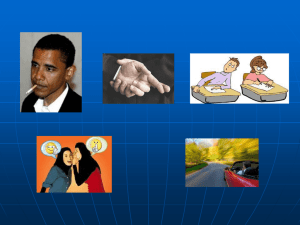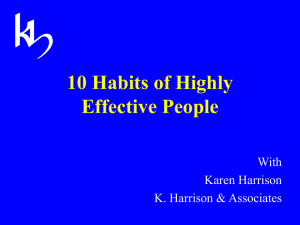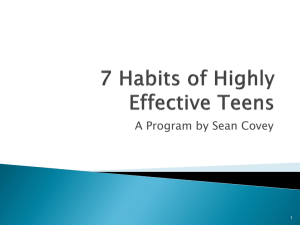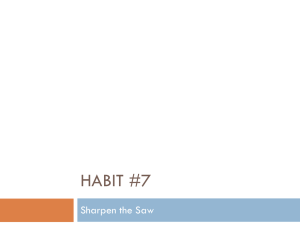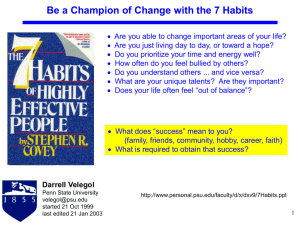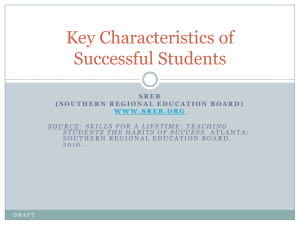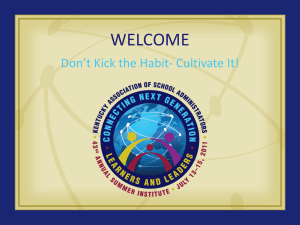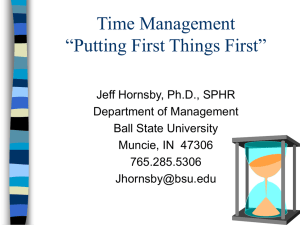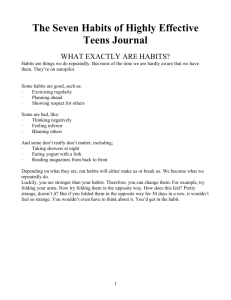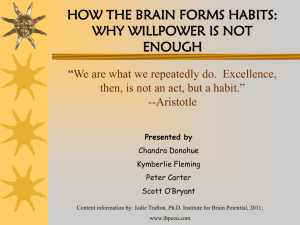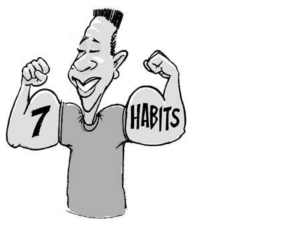The 7 Habits of Highly Effective Teachers
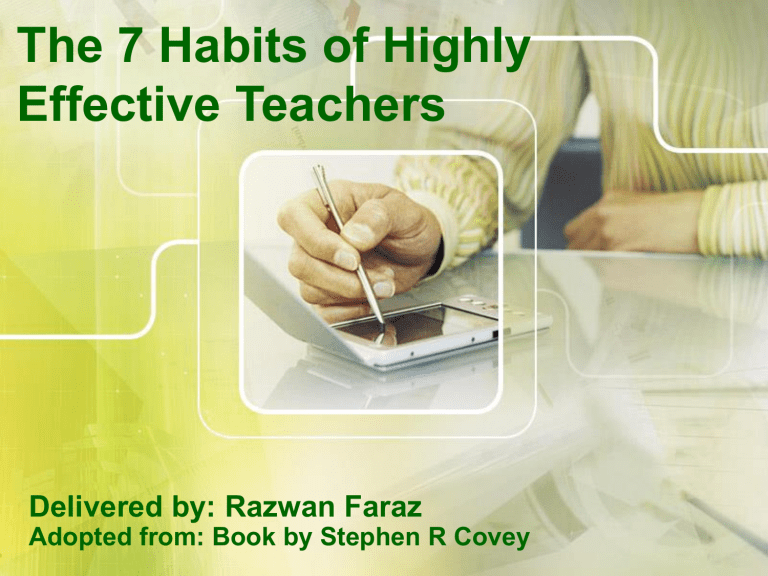
The 7 Habits of Highly
Effective Teachers
Delivered by: Razwan Faraz
Adopted from: Book by Stephen R Covey
Discussion
1. If you could be anything, what would you be?
– What is stopping you?
2. If you could do anything, what would you do?
– What is stopping you?
3. If you could have any strength/quality in your character, which ones would you have?
– What is stopping you?
100
90
80
70
60
50
40
20
0
10%
Read
20%
Hear
30%
See
We Learn. . .
95%
Teach
80%
Experi-
70%
Discuss ence
50%
See &
Hear
William Glasser
When all you own is a hammer, every problem starts looking like a nail
Abraham Maslow
I say:
When you see everything as a nail, you beat yourself for not owning a hammer!
Discussion
• What is neotony?
The state resulting when juvenile characteristics are retained by the adults of a species (Dictionary.com)
The 7 Habits
7
Sharpen saw
Interdependence
Understand
5
PUBLIC
VICTORY
Synergize
6
Think win-win
4
Independence
3
1 st things 1 st
PRIVATE
1
Be Proactive
VICTORY
2
End in mind
Dependence
Discussion
• What significance does our paradigm have on our behaviour?
• How does the prior knowledge we have of a child effect the way we behave with that child and the way they behave with us?
Thoughts become actions
A man found an eagles egg and put it in the nest of a barnyard hen. The eagle hatched with the brute of chicks and grew up with them. All his life the eagle did what the barnyard chicks did, thinking he was a barnyard chicken.
He scratched the earth for worms and insects, he clucked and cackled and thrashed his wings and would fly a few feet into the air. Years passed by and the eagle grew very old. One day he saw a magnificent bird above him in the cloudless sky. It glided in graceful majesty among the powerful wind currents. The old eagle looked up in awe ‘who is that?’ he asked. ‘That’s the eagle, the king of the birds’ said his neighbour, ‘he belongs to the sky we belong to the earth, because we are chickens’.
So the eagle lived and died a chicken, for that’s what he thought he was.
Every great breakthrough is a break WITH.
If you want to make minor improvements, work on behavior and attitudes. If you want to make quantum improvements, work on paradigms. A paradigm is like a mental model, an assumption, or a map.
“All people see the world, not as it is, but as they are” - Covey
What is the profession of these people?
Circle of
Concern
Circle of
Influence
What do we not see?
Excellence is an art won by training and habituation. We are what we repeatedly do. Excellence, then, is not an act, but a habit
Aristotle
Knowledge
(what to, why to)
Skills
(how to)
Habits
Desire
(want to)
Habits
Internalized principles
& patterns of behavior
Anonymous
Be careful of your thoughts
For your thoughts become your words
Be careful of your words
For your words become your actions
Be careful of your actions
For your actions become your habits
Be careful of your habits
For your habits become your character
Be careful of your character
For your character becomes your destiny.
Habit 1
Habit 1 Be proactive
Raise your hand if you have said 3 or more of the following:
• I cant
• I have to go
• I don’t know how
• He makes me so mad!
• There is nothing I can do
• She thinks I am not good at….
• I cant control that class!
• I hate Mondays
Food for thought…
Between stimulus and response there is a space. In that space is our power to choose our response. In our response lies our growth and our freedom.
Viktor E. Frankl
Responsibility
Response Ability
Stimulus
Stimulus and Response
Proactive
Freedom to Choose
Response
Self-Awareness……..Heart
Imagination………….Mind
Conscience…………..Spirit
Independent Will…….Body
Stimulus
Reactive
Response
Internal frame of reference / selfreferential person:
Uses themselves as the context or reference frame. Considers their model of the world as the standard by which others are judged. Compares progress made to their own standards and works to improve against their own past results as opposed to that of others
Discussion
• List 3 areas where you react negatively on a regular basis to a stimulus outside of you
• What proactive actions will you now take to ensure you are in control of the response to these actions
• What mental attitude must you adopt in order to fulfil these actions?
habit 2 begin with the end in mind
Habit 2: Begin With
The End In Mind
“Would you tell me, please, which way I ought to go from here?”
"That depends a good deal on where you want to get to," said the Cat.
"I don’t much care
where," said Alice.
"Then it doesn’t matter which way you go," said the
Cat.
Mission Statement
Example
"My mission is to champion others to grow personally, professionally, emotionally and spiritually by using my compassion, my unique perspective, and my belief in others' inherent goodness, integrity, and enormous potential."
Discussion – End in
Mind
• What vision do you have for yourself?
• What vision do you have for the children you teach?
• List 5 actions you have taken that have brought you closer to these visions.
habit 3 put first things first
Habit 3 ... a demonstration.
What is the lesson?
The Time Management Matrix
Urgent
• Exam tomorrow
• Friend gets injured
• Late for work/class
• Project due today
Not Urgent
Planning, goal setting
• Paper due in a week
• Exercise
• Relationships/relaxation
• Unimportant phone calls
• Interruptions
• Other people’s small problems
• Peer pressure
• Too much TV
• Endless phone calls
• Excessive computer games
• Retail therapy
• Other time wasters
The Time Management Matrix
Urgent
I The Procrastinator
Stress
Burnout
Crisis management
Always putting out fires
Not Urgent
II The Visionary
Vision, perspective
Balance
Discipline
Control
Few crises
III The Yes-man
Short-term focus
Crisis management
Reputation-chameleon type character
See goals and plans as worthless
Feel victimized, out of control
Shallow or broken relationships
IV The Slacker
Total irresponsibility
Fired from jobs
Dependent on others or institutions for basics
Short term & Long term goals
• What is the most productive thing that you can be doing with your time right now?
• What can you do in the next 10 minutes?
• What can you do today?
• What can you do this week?
• What can you do this month?
• What can you do this term?
• What can you do this year?
• What can you do in the next 10 years?
Private Victory
H1. Be proactive – you are the programmer
H3. First things first
You run the program
H2. End in mind write the program
habit 4, 5 and 6 – Public Victory
H4. Win/Win
Public Victory – The art of influencing
H5. Seek 1st to
Understand and then to be understood
H6. Synergy
Role Play H4, 5 & 6
• Groups of 3: Parent, teacher and observer.
• Parent teacher confrontation. Refer to notes.
habit 7 – Sharpen the saw
Mental
Reading, Visualizing
Planning, Writing
IQ
To Learn
Physical
Exercise, Nutrition
Spiritual
Value Clarification
& Commitment, Study
& Meditation
SQ
To Leave a Legacy
Habit 7
Stress Management
PQ
To Live
Social/Emotional
Service, Empathy
Synergy, Intrinsic Security
EQ
To Love
Mental
Action planning
Time management
Strategy games-chess/bridge
Reading (non fiction)
Reviewing
Gathering information
Clearing clutter
Ordering/tidying up
Organising wardrobe/desk
Activities to develop intelligence
Physical
Competitive sport
Working out-Gym
Martial arts- Karate
Physical tasks/ targets
Extreme sports
Archery/shooting
Hunting/fishing
Mountaineering
Studying body language
Spiritual
Dhikr / Reading Quran
Relaxation / Meditation
Walk in nature
Being in or near water
Slow hot both
Proper diet
Gardening
Massage- Aromatherapy
Tai Chi/ Meditation
Quiet time with family
Activities to develop intelligence
Social/Emotional
Artistic: Painting
Poetry
Pottery
Amateur dramatics
Playing/ self expression
Spontaneity
Doing the unfamiliar
Brainstorming
Dependence
7 habits - overview
Independence Habits 1, 2 and 3
Interdependent
Habits 4, 5 and 6
Habit 7 The pathway of the 7habits

